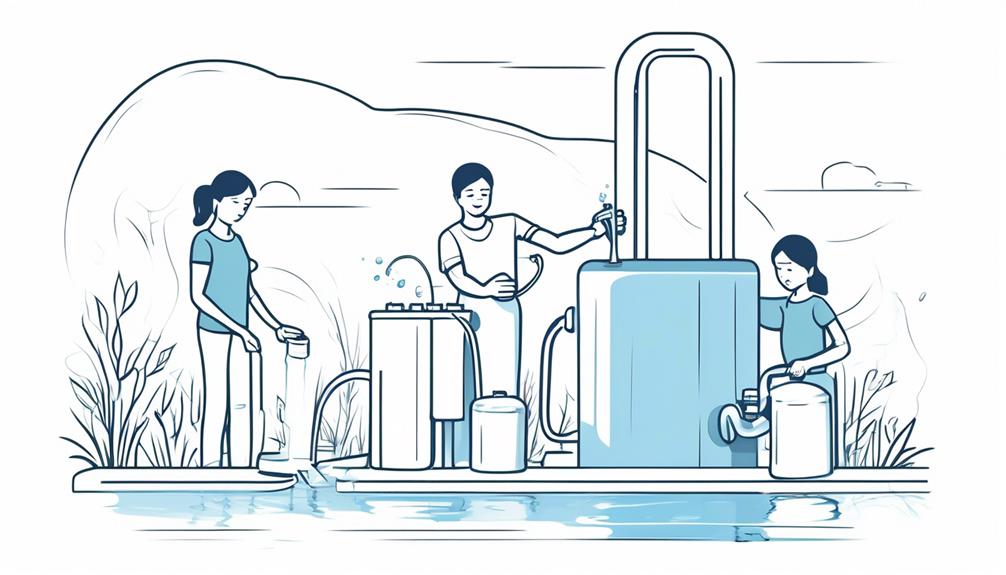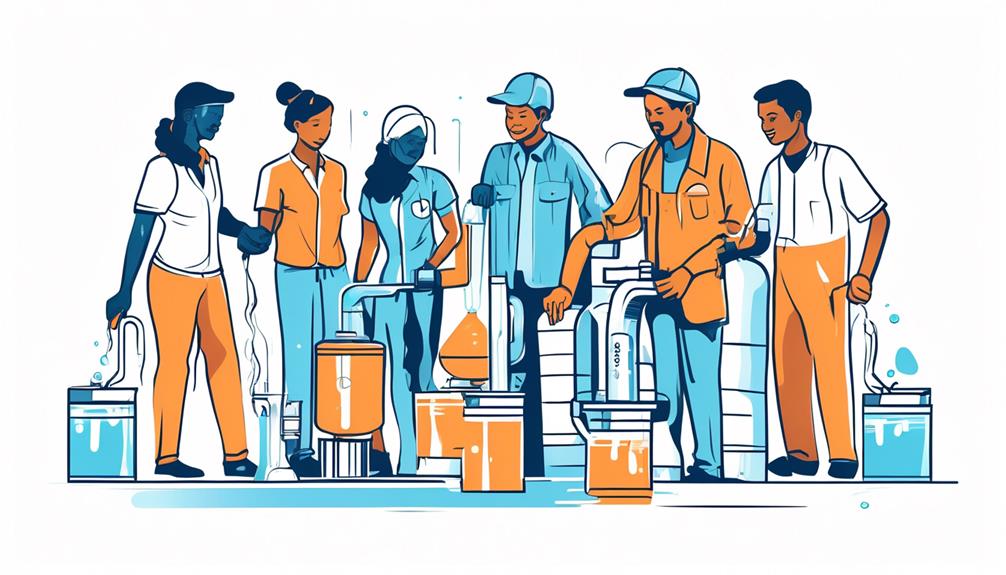When it comes to securing your health, ensuring safe water is paramount. You might be surprised at how much water quality impacts your well-being.
From understanding waterborne diseases to the importance of water quality testing and effective treatment methods, there's a whole world beneath the surface that affects your health.
Discover how simple changes in water safety practices and community engagement can make a significant difference in your health security.
Key Takeaways
- Regular water quality testing is essential for detecting and preventing waterborne diseases early on.
- Utilizing effective water treatment methods like chlorination, filtration, boiling, and UV disinfection ensures water safety.
- Community engagement and collaboration play a crucial role in enhancing health security and promoting safe water practices.
- Education and promotion of healthier environments through open dialogue and empowering individuals to take charge of their health are vital in preventing waterborne diseases.
Understanding Waterborne Diseases
Waterborne diseases lurk in contaminated water sources, posing a significant risk to public health worldwide. Understanding these diseases is crucial for prevention. One common waterborne illness is cholera, caused by ingesting water contaminated with the Vibrio cholerae bacterium. Symptoms include severe diarrhea and dehydration, leading to rapid health deterioration if untreated.
Another well-known disease is giardiasis, caused by the Giardia parasite found in contaminated water. Symptoms include stomach cramps, diarrhea, and weight loss. Hepatitis A is also a waterborne virus that affects the liver and can lead to jaundice and fatigue.
Common Waterborne Pathogens
Having understood the risks associated with waterborne diseases, let's now explore the realm of common pathogens that lurk in contaminated water sources. These microorganisms pose a threat to your health and well-being, emphasizing the crucial need for safe water practices.
Here are four common waterborne pathogens to be wary of:
- Escherichia coli (E. coli): This bacteria can cause severe gastrointestinal issues, leading to symptoms like diarrhea, stomach cramps, and vomiting. It's commonly found in fecal matter-contaminated water sources.
- Giardia lamblia: This parasite targets the intestines, causing symptoms such as diarrhea, gas, and dehydration. It's often present in untreated water in streams or rivers.
- Norovirus: Known for causing outbreaks of gastroenteritis, this virus results in symptoms like nausea, vomiting, and stomach cramps. It spreads easily in contaminated water reservoirs.
- Cryptosporidium: This protozoan parasite can lead to prolonged diarrhea, especially in individuals with weakened immune systems. It's resistant to traditional water disinfection methods, making it a persistent threat.
Stay vigilant and prioritize water safety to protect yourself from these harmful pathogens.
Importance of Water Quality Testing
Hey there! Ready to learn about the importance of water quality testing?
Discover the various testing methods used and how they directly impact your health.
Let's dive into how testing ensures the safety of the water you use every day.
Testing Methods Overview
When ensuring the safety of your water supply, understanding the importance of water quality testing becomes crucial. Testing methods play a vital role in safeguarding your health and that of your loved ones.
Here are four reasons why water quality testing is essential:
- Peace of Mind: Regular testing ensures that your water is safe to drink, providing peace of mind for you and your family.
- Early Detection: Testing helps in the early detection of contaminants, allowing for prompt corrective actions to be taken.
- Health Protection: By testing your water quality, you're actively protecting your health and well-being from potential waterborne diseases.
- Environmental Impact: Monitoring water quality contributes to preserving the environment and ensuring a sustainable water supply for future generations.
Impact on Health
To understand the impact of water quality testing on health, consider the direct link between clean water and overall well-being. Regular testing ensures that the water you consume is free from harmful contaminants, safeguarding your health and preventing waterborne diseases. Here's a quick comparison highlighting the importance of water quality testing:
| Benefits of Water Quality Testing | Impact on Health |
|---|---|
| Early detection of contaminants | Reduces risk of illnesses |
| Ensures compliance with safety standards | Promotes better overall health |
| Provides peace of mind | Increases confidence in water quality |
Effective Water Treatment Methods
Implementing effective water treatment methods is crucial for ensuring the safety and cleanliness of drinking water. Here are four key methods that can help protect you and your loved ones from waterborne diseases:
- Chlorination: This common method involves adding chlorine to water to kill disease-causing microorganisms, ensuring your water is safe to drink.
- Filtration: By passing water through various filters, contaminants like bacteria, parasites, and chemicals are removed, making the water safer for consumption.
- Boiling: Boiling water is a simple yet effective way to kill harmful bacteria and viruses, providing you with clean water to drink and cook with.
- Ultraviolet (UV) Disinfection: UV light is used to inactivate bacteria and other pathogens in water, offering a chemical-free method to ensure water safety.
Implementing Water Safety Practices

Let's kick off the discussion on implementing water safety practices!
You'll learn about different purification methods, how to monitor water quality effectively, and the importance of community education initiatives in preventing waterborne diseases.
These points are crucial in ensuring that you and your community have access to safe and clean water sources.
Purification Methods Overview
For effective waterborne disease prevention, understanding different water purification methods is crucial. Here's a quick overview to help you navigate through the options:
- Boiling: Nothing beats the simplicity and effectiveness of boiling water to kill harmful pathogens. It's like giving those germs a taste of their own medicine!
- Chlorination: Adding chlorine to water may sound like a pool party, but for those microbes, it's more like a chlorine apocalypse!
- Filtration: Imagine a water filter as a superhero, swooping in to save the day by trapping contaminants and leaving you with pure, clean water.
- UV Water Purification: Harnessing the power of ultraviolet light, this method zaps those pesky microorganisms, ensuring your water is as clear as a sunny day.
Stay informed, stay safe!
Monitoring Water Quality
As you explore ways to keep your water safe through various purification methods, ensuring the quality of your water remains a top priority. Monitoring water quality is crucial in preventing waterborne diseases. Here are some key parameters to regularly check in your water sources:
| Parameter | What it Tests For |
|---|---|
| Turbidity | Presence of suspended particles |
| pH Level | Acidity or alkalinity of water |
| Chlorine Residual | Effectiveness of disinfection |
Regularly monitoring these factors can help you detect any abnormalities in your water quality early on, allowing you to take necessary actions to maintain safe drinking water for you and your family. Remember, prevention is always better than cure when it comes to waterborne illnesses.
Community Education Initiatives
Engage your community in learning and practicing essential water safety measures to protect against waterborne diseases. By implementing community education initiatives, you can make a significant impact on public health.
Here are four ways to get started:
- Host Workshops: Gather community members to participate in interactive workshops on water safety practices.
- Distribute Educational Materials: Share pamphlets and posters outlining the importance of clean water and proper hygiene.
- Demonstrate Proper Techniques: Show how to purify water, wash hands effectively, and maintain clean water sources.
- Encourage Open Dialogue: Foster discussions about waterborne diseases and how simple precautions can prevent them.
Together, we can create a healthier and safer environment through education and action.
Community Engagement for Health Security

To enhance health security within your community, active involvement and collaboration are essential. By engaging with your neighbors, local organizations, and health authorities, you can work together to prevent waterborne diseases and promote safe water practices. Community engagement empowers individuals to take ownership of their health and well-being, creating a network of support and resources for everyone.
One way to engage with your community is to participate in workshops or training sessions focused on water safety and disease prevention. These interactive sessions provide valuable information and practical skills that can benefit the entire neighborhood. Additionally, organizing clean-up events for local water sources or volunteering with water sanitation projects can make a tangible difference in reducing the risk of waterborne illnesses.
Furthermore, establishing a community task force dedicated to health security can ensure ongoing efforts and coordination in addressing water-related health concerns. By fostering a culture of collaboration and shared responsibility, you can contribute to a safer and healthier environment for all community members. Remember, your active participation is key to securing a healthier future for everyone.
Frequently Asked Questions
Can Waterborne Diseases Be Transmitted Through Swimming Pools and Recreational Water Sources?
Yes, waterborne diseases can be transmitted through swimming pools and recreational water sources. Always practice good hygiene before entering the water. Avoid swallowing pool water, and ensure pools are properly maintained and chlorinated to prevent infections.
How Do Climate Change and Extreme Weather Events Impact the Prevalence of Waterborne Diseases?
Climate change and extreme weather events can increase the prevalence of waterborne diseases. Flooding can contaminate water sources, leading to outbreaks. Warmer temperatures can also promote bacterial growth in water. It's crucial to monitor and address these risks for public health protection.
What Are Some Emerging Waterborne Pathogens That Are Becoming a Concern for Public Health Officials?
Hey there! Public health officials are keeping an eye on emerging waterborne pathogens like Naegleria fowleri and Elizabethkingia anophelis. Stay informed and take precautions to protect yourself and your loved ones. Stay safe!
Are There Specific Populations or Demographics That Are More Vulnerable to Waterborne Diseases?
You might wonder if certain populations are more at risk of waterborne diseases. Yes, infants, elderly, pregnant women, and those with weakened immune systems are more vulnerable. It's crucial to ensure safe water access for them.
How Can Individuals Protect Themselves From Waterborne Diseases While Traveling to Different Regions With Varying Water Quality Standards?
When traveling to areas with varying water quality, always use bottled or boiled water for drinking and brushing teeth. Avoid ice, raw foods rinsed in water, and unsealed beverages. Remember, simple precautions can keep you healthy.
Conclusion
Now that you have learned about the importance of safe water in preventing waterborne diseases, remember to always prioritize water quality testing and treatment methods.
By implementing water safety practices and engaging with your community, you can ensure a healthier and happier future for everyone.
So go ahead, dive into the world of clean water – it's like a refreshing oasis in a desert of uncertainty!